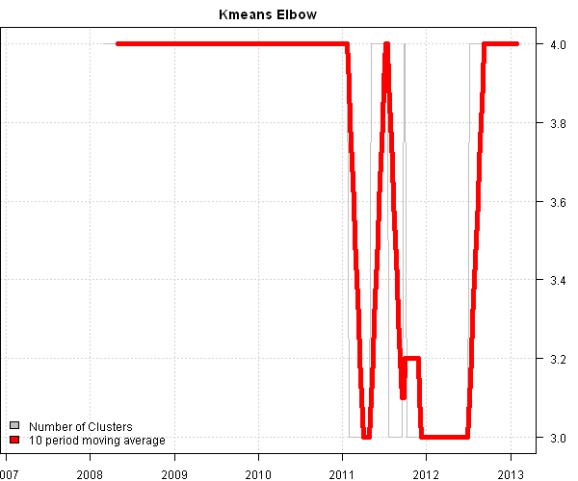Tracking Number of Historical Clusters
Want to share your content on R-bloggers? click here if you have a blog, or here if you don't.
In the prior post, Optimal number of clusters, we looked at methods of selecting number of clusters. Today, I want to continue with clustering theme and show historical Number of Clusters time series using these methods.
In particular, I will look at the following methods of selecting optimal number of clusters:
- Minimum number of clusters that explain at least 90% of variance
- Elbow method
- Hierarchical clustering tree cut at 1/3 height
Let’s first load historical prices for the 10 major asset classes
###############################################################################
# Load Systematic Investor Toolbox (SIT)
# http://systematicinvestor.wordpress.com/systematic-investor-toolbox/
###############################################################################
setInternet2(TRUE)
con = gzcon(url('http://www.systematicportfolio.com/sit.gz', 'rb'))
source(con)
close(con)
#*****************************************************************
# Load historical data for ETFs
#******************************************************************
load.packages('quantmod')
tickers = spl('GLD,UUP,SPY,QQQ,IWM,EEM,EFA,IYR,USO,TLT')
data <- new.env()
getSymbols(tickers, src = 'yahoo', from = '1900-01-01', env = data, auto.assign = T)
for(i in ls(data)) data[[i]] = adjustOHLC(data[[i]], use.Adjusted=T)
bt.prep(data, align='remove.na')
Next, I created 3 helper functions to automate cluster selection. In particular, I used following methods of selecting optimal number of clusters:
- Minimum number of clusters that explain at least 90% of variance – cluster.group.kmeans.90 function
- Elbow method – cluster.group.kmeans.elbow function
- Hierarchical clustering tree cut at 1/3 height – cluster.group.hclust function
To view the complete source code for these functions please have a look at the startegy.r at github.
Let’s use these functions on our data set every week with 250 days look-back to compute correlations.
#*****************************************************************
# Use following 3 methods to determine number of clusters
# * Minimum number of clusters that explain at least 90% of variance
# cluster.group.kmeans.90
# * Elbow method
# cluster.group.kmeans.elbow
# * Hierarchical clustering tree cut at 1/3 height
# cluster.group.hclust
#******************************************************************
# helper function to compute portfolio allocation additional stats
portfolio.allocation.custom.stats.clusters <- function(x,ia) {
return(list(
ncluster.90 = max(cluster.group.kmeans.90(ia)),
ncluster.elbow = max(cluster.group.kmeans.elbow(ia)),
ncluster.hclust = max(cluster.group.hclust(ia))
))
}
#*****************************************************************
# Compute # Clusters
#******************************************************************
periodicity = 'weeks'
lookback.len = 250
obj = portfolio.allocation.helper(data$prices,
periodicity = periodicity, lookback.len = lookback.len,
min.risk.fns = list(EW=equal.weight.portfolio),
custom.stats.fn = portfolio.allocation.custom.stats.clusters
)
Finally, the historical number of cluster time series plots for each method:
#*****************************************************************
# Create Reports
#******************************************************************
temp = list(ncluster.90 = 'Kmeans 90% variance',
ncluster.elbow = 'Kmeans Elbow',
ncluster.hclust = 'Hierarchical clustering at 1/3 height')
for(i in 1:len(temp)) {
hist.cluster = obj[[ names(temp)[i] ]]
title = temp[[ i ]]
plota(hist.cluster, type='l', col='gray', main=title)
plota.lines(SMA(hist.cluster,10), type='l', col='red',lwd=5)
plota.legend('Number of Clusters,10 period moving average', 'gray,red', x = 'bottomleft')
}
All methods selected clusters a little bit differently, as expected. The “Minimum number of clusters that explain at least 90% of variance” method seems to produce the most stable results. I would suggest looking at the larger universe (for example DOW30) and longer period of time (for example 1995-present) to evaluate these methods.
Takeaways: As I mentioned in the Optimal number of clusters post, there are many different methods to create clusters, and I have barely scratched the surface. There is also another dimension that I have not explored yet, the distance matrix. Currently, I’m using a correlation matrix as a distance measure to create clusters. I was pointed out by Matt Considine that there is an R interface to the Maximal Information-based Nonparametric Exploration (MINE) metric that can be used as a better measure of correlation.
To view the complete source code for this example, please have a look at the bt.cluster.optimal.number.historical.test() function in bt.test.r at github.
R-bloggers.com offers daily e-mail updates about R news and tutorials about learning R and many other topics. Click here if you're looking to post or find an R/data-science job.
Want to share your content on R-bloggers? click here if you have a blog, or here if you don't.



